College Ave. Traffic Calming Concept Maps
The City of Tempe has released concept maps for the College Ave. traffic calming and pedestrian / bicycle improvements project. These maps were first presented at the October 18th neighborhood meeting and are now available for download [PDF]. The planned traffic calming measures will significantly alter the feel of College Ave by introducing narrower streets and improved “streetscaping“. The end result should be slower traffic speeds on College and greater safety for cyclists and pedestrians.
The City of Tempe is still accepting comments on the College Ave. project, so please take a moment to review the concept maps and get involved in the process by commenting (either for or against) on this important redesign of Tempe’s busiest bicycle artery. Also available on the website is a compilation of the comments [PDF] that have already been submitted.
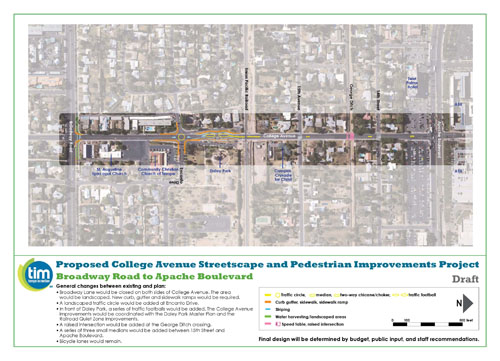
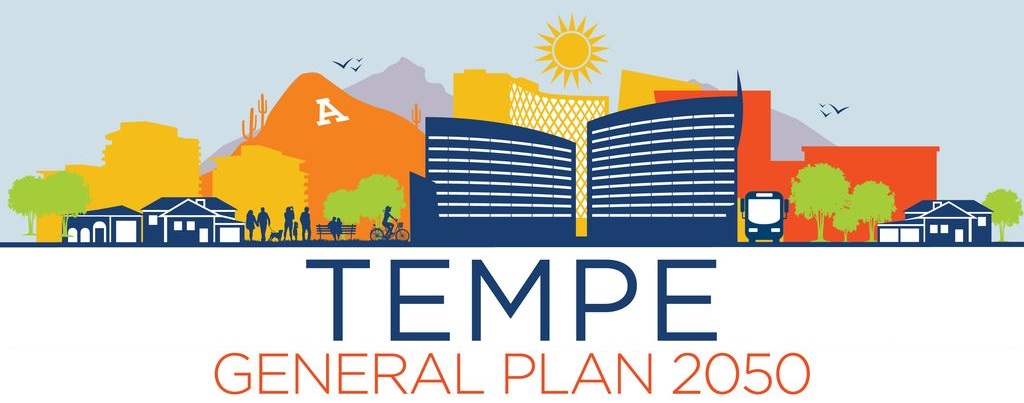



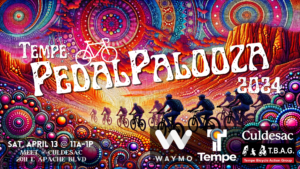
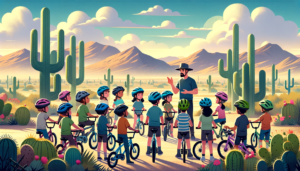
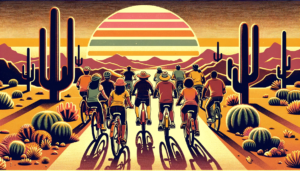

I am concerned that this loss of “5 feet of pavement” to landscaping/drainage will mostly affect bicyclists and I have submitted these concerns to Tempe. If you look at 5th street, bike lanes are narrowed and bikes are squeezed closer to cars. I feel safer on College now with cars going 40mph because I have 10+ feet to work with as opposed to the 4 or so feet on 5th street even though cars are only going 25mph. If you agree, please submit your comments to Tempe about keeping the bike lanes WIDE and not squeezing bike traffic too close to car traffic even though speeds will be reduced. I think maybe bike lanes on college should be integrated into a wider sidewalk that’s divided for bikes/peds? Alternatively perhaps soft curbing separating the bike lane. Alot of comments I read are directed at bicyclists breaking the law (wrong side riding, etc) so I think some education of cyclists needs to be done.
Funny how we spend all this money for one road, yet at the same time we have very few crosswalks to help up cross the street throughout the rest of the city.
The wider the lanes the better. And remember that Collage is one of the most heavily trafficked bike routes in the country so it makes sense to improve it. Also, the city will be spending a lot of money on the Western Canal and other dedicated paths so this isn’t the only project they’re working on (not that we don’t need more).
The lanes should be kept wide, unstripped, and free of obsticals like bulb outs, etc. That adds danger to cyclists – especially at night. Especially the ones shown between Southern and Alameda which squeeze the cyclist between the sidewalk and the inside of the bulbout right before intersections. That will lead to more right hooks.
I’m not so sure about the roundabout for example at Alameda. Right now it’s an easy left turn from the left turn lanes. Now one needs to circle around 270deg of the roundabout for a left turn and watch for entering traffic.
I cycle thru here daily (during 5pm ‘rush hour’) and the biggest issue for cyclist safety is cyclists riding the wrong way, making turns without looking/signaling and not having lights at night.
If motorist speeding is a problem, then enforce it. Motorists will get used to the obsticals intended to slow them down.
Money for improving cycling infrastructure should be spend on widening lanes on roads like Southern and Baseline, etc, instead of adding driving hazards to back roads like College which are already very comfortable to cycle on.
Here’s my commentary as posted on the comment form:
I’m a bit concerned about interactions between bicycles and cars at intersections with traffic circles, mostly for the sake of bicyclists seeking to turn left at any intersection. It seems to me that the traffic circles will reduce wrong-way riding at key intersections (e.g. College and Encanto), but I’m not sure that the current measures will make it safe for bicycles to merge with traffic while going around traffic circles and making left-hand turns. Will bike lanes fade out at the traffic circles, and will signage indicate that bikes and cars should merge? This could be especially problematic during peak traffic hours. Several traffic circles in Phoenix seem to have already handled this situation well and should be used as examples (e.g. along 12th Street).
My impression is that the other traffic calming measures should slow speeds enough to make merging maneuvers less dangerous, but it seems like the relationship between cars and bikes is still too ambiguous with the proposed plans along College Ave, especially at intersections. I would personally prefer to see a more clear transition to a better shared street space (perhaps “sharrows” should indicate where cars and bikes need to get along with each other?) which would encourage cars to slow down and bicyclists to see themselves as vehicles instead of speedy pedestrians.
Narrowing the street could have two positive effects: it could slow down cars enough to prevent the most serious accidents between cars, pedestrians, and bicyclists (accidents above 30 mph are potentially fatal); and it could force cars to be more careful when passing bicyclists (wide lanes encourage passing when there really isn’t enough room for it to be safe for the cyclist).
—
Clearly, the plans for College Ave will dramatically change how it is used–I think the changes could be improvements in the long run, but it will take some time to adjust to how they will alter the relationships between cars and bikes–there’s education in the form of telling bicyclists, “This is the proper place to ride your bike,” but then the current traffic calming plan educates by making it more uncomfortable to ride a bike in the wrong places and comfortable to ride where bikes should be riding.
So far, Tempe’s biking infrastructure has encouraged segregation of cars and bikes, making it so that bicyclists like myself are afraid to ride on streets without bike lanes (i.e. every major road like Rural or Southern with zippy traffic that doesn’t look for bikes in the road). I’d actually prefer to see streets that encourage cars and bikes to safely and effectively share space. Separate is not equal.